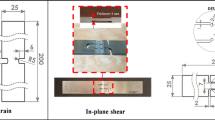The conditions of circumferential fracture during hot radial-shear rolling are simulated using QForm software. The fields of modified Cockroft–Latham criterion and temperature are plotted. The results of simulation were validated experimentally by rolling bars made of creep-resistant alloy. Controlled circumferential fracture was created by intensifying the self-heating by increasing the rolling speed. The fracture zone was examined metallographically. The experiment confirmed that the main cause of circumferential fracture of the workpiece during radial-shear rolling is the rapid self-heating in the fracture zone rather than the stress state and ductility of the material. These results were confirmed by examining the fracture zone with a microscope.










Similar content being viewed by others
References
I. N. Potapov and P. I. Polukhin, Helical Rolling Technology [in Russian], Metallurgiya, Moscow (1990).
A. I. Tselikov, M. V. Barbarich, M. V. Vasil’chikov, et al., Special Rolling Mills [in Russian], Metallurgiya, Moscow (1971).
B. Romantsev, A. Goncharuk, A. Aleshchenko, Y. Gamin, and M. Mintakhanov, “Development of multipass skew rolling technology for stainless steel and alloy pipes’ production,” Int. J. Adv. Manufact. Techn., 97, No. 9–12, 3223–3230 (2018).
S. P. Galkin, Theory and Technology of Stationary Screw Rolling of Billets and Bars Made of Nonductile Steels and Alloys [in Russian], Author’s Abstract of Dr.Sci. Thesis, MISiS, Moscow (1998).
S. P. Galkin, “Trajectory of deformed metal as basis for controlling the radial-shift and screw rolling,” Stal’, No. 7, 63–66 (2004).
S. P. Galkin, B. A. Romantsev, and E. A. Kharitonov, “Putting into practice innovative potential in the universal radial-shear rolling process,” CIS Iron and Steel Review, 9, No. 9, 35–39 (2014).
B. V. Karpov, P. V. Patrin, S. P. Galkin, E. A. Kharitonov, and I. B. Karpov, “Radial-shear rolling of titanium alloy VT-8 bars with controlled structure for small diameter ingots (< 200 mm),” Metallurgist, 61, No. 9–10, 884–890 (2018).
S. Dobatkin, S. Galkin, Y. Estrin, V. Serebryany, et al., “Grain refinement, texture, and mechanical properties of a magnesium alloy after radial-shear rolling,” J. Alloys and Compounds, 774, 969–979 (2019).
T. Akopyan, A. S. Aleshchenko, N. A. Belov, and S. P. Galkin, “Effect of radial-shear rolling on the formation of structure and mechanical properties of Al–Ni and Al–Ca aluminum-matrix composite alloys of eutectic type,” Physics of Metals and Metallography, 119, No. 3, 241–250 (2018).
V. Sheremetyev, A. Kudryashova, S. Dubinskiy, S. Galkin, et al., “Structure and functional properties of metastable beta Ti- 18Zr-14Nb (at.%) alloy for biomedical applications subjected to radial shear rolling and thermomechanical treatment,” J. Alloys and Compounds, 737, 678–683 (2018).
A. D. Tomlenov, Theory of Plastic Deformation of Metals [in Russian], Metallurgiya, Moscow (1972).
Y. Chastel, A. Diop, S. Fanini, P. O. Bouchard, and K. Mocellin, “Finite element modeling of tube piercing and creation of a crack,” Int. J. Material Forming, 1, No. S1, 355–358 (2008).
Z. Pater, J. Bartnicki, and J. Kazanecki, “3D finite element method (FEM) analysis of basic process parameters in rotary piercing mill,” Metallurgist, 51, No. 4, 501–504 (2012).
M. M. Skripalenko, B. A. Romantsev, S. P. Galkin, M. N. Skripalenko, et al., “Prediction of the fracture of metal in the process of screw rolling in a two-roll mill,” Metallurgist, 61, No. 11–12, 925–933 (2018).
M. M. Skripalenko, S. P. Galkin, H. J. Sung, B. A. Romantsev, et al., “Prediction of potential fracturing during radial-shear rolling of continuously cast copper billets by means of computer simulation,” Metallurgist, 62, No. 9–10, 849–856 (2019).
S. Stebunov, N. Biba, A. Vlasov, and A. Maximov, “Thermally and mechanical coupled simulation of metal forming processes,” in: Proc. 10th Int. Conf. on Technology of Plasticity, Aachen, Germany (2011), pp. 171–175.
S. Stebunov, A. Vlasov, and N. Biba, “Prediction of fracture in cold forging with modified Cockcroft–Latham criterion,” in: Proc. 17th Int. Conf. on Metal Forming (September 16–19, 2018), Toyahashi, Japan (2018), pp. 519–526.
V. L. Kolmogorov, Stress, Strain, and Fracture [in Russian], Metallurgiya, Moscow (1970).
A. V. Vlasov, S. A. Stebunov, S. A. Evsyukov, N. V. Biba, and A. A. Shitikov, Finite-Element Modeling of Stamping and Forging Processes [in Russian], Izd. MGTU im. N. E. Baumana, Moscow (2019).
V. L. Kolmogorov, Plasticity and Fracture [in Russian], Metallurgiya, Moscow (1977).
Author information
Authors and Affiliations
Corresponding author
Additional information
Translated from Metallurg, Vol. 64, No. 3, pp. 64–70, March, 2020.
Rights and permissions
About this article
Cite this article
Galkin, S.P., Stebunov, S.A., Aleschenko, A.S. et al. Simulation and Experimental Evaluation of Circumferential Fracture Conditions in Hot Radial–Shear Rolling. Metallurgist 64, 233–241 (2020). https://doi.org/10.1007/s11015-020-00988-9
Received:
Published:
Issue Date:
DOI: https://doi.org/10.1007/s11015-020-00988-9




